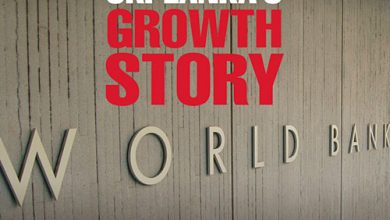ECONOMIC RECAP
SIGNS OF A RECOVERY
Shiran Fernando reviews the recent performance of the national economy and expectations for year 2021
Sri Lanka’s growth numbers for the second and third quarters of last year were released in December by the Department of Census and  Statistics. As expected, the second quarter (April-June) recorded a sharp year on year contraction of 16.3 percent, reflecting the impact of the initial impact of the pandemic and extended curfew.
Statistics. As expected, the second quarter (April-June) recorded a sharp year on year contraction of 16.3 percent, reflecting the impact of the initial impact of the pandemic and extended curfew.
Meanwhile, the third quarter (July-September) recorded a growth of 1.5 percent. As a result, the economy recorded a contraction of 5.3 percent during the first nine months of 2020.
The fourth quarter data is likely to be released in mid-March, barring any unforeseen delays. This figure is expected to be somewhat below the third quarter growth of 1.5 percent, reflecting the impact of the second wave of the virus.
This should still see overall growth for 2020 to be negative. According to its annual road map, the Central Bank of Sri Lanka expects growth to amount to 3.9 percent. However, forecasters expect a steeper fall – for example, the World Bank is projecting a contraction of 6.7 percent for 2020.
AGRICULTURE The agriculture sector – which encompasses forestry and fishing – contracted for three consecutive quarters from October-December 2019 to April-June last year.
However, it registered a year on year growth of 4.3 percent in the third quarter of 2020, led by growing vegetables and rice, animal production, and a narrowing contraction in marine fishing and aquaculture.
According to the Dep artment of Agriculture, this year’s Maha season is expected to witness a 10 percent decline in rough rice production based on cultivation so far. This may not augur well for the paddy related sub-sector under agriculture.
artment of Agriculture, this year’s Maha season is expected to witness a 10 percent decline in rough rice production based on cultivation so far. This may not augur well for the paddy related sub-sector under agriculture.
INDUSTRY Industrial activity recorded the sharpest contraction in the second quarter of 23 percent but recovered to grow by 0.6 percent.
The main sub-sectors such as mining, the manufacture of apparel, rubber, and food and beverage, experienced disruptions due to the curfew in the second quarter and recovered in the following three months.
Construction – which accounts for about seven percent of GDP and is another important sub-sector in this segment – contracted by 30 percent in the second quarter. It did not see growth in the third quarter but rather, a narrowing in contraction of slightly over nine percent.
The sub-sectors that remained opened despite the impact of the second wave would boost growth in the last quarter and heading into 2021 as well.
SERVICES The services sector witnessed a near 13 percent contraction in the second quarter followed by an impressive recovery in the third with a hike of two-plus percent.
Important sub-sectors such as wholesale and retail trade, and transportation (which contracted sharply in the second quarter) recovered in the subsequent quarter to help service activities post this growth.
Moreover, sub-sectors such as IT and telecommunications remained resilient and witnessed more activity during the year, and continued to register impressive growth rates.
In contrast, the accommodation, and food and beverage service activities (which capture tourism activities) continued to experience sharp contractions in both the second and third quarters. This trend would be expected to continue in the fourth quarter.
However, the contraction may narrow with the gradual opening of the airport and arrival of tourists as planned by the government at the time of writing. It may take until the second half of this year to see service activities experience a boost from the influx of tourism provided that the pandemic does not worsen.
ECONOMIC OUTLOOK The expectation for growth in 2021 is varied depending on the forecasts released.
The World Bank expects growth to be 3.3 percent, while the IMF and ADB have projected 5.3 percent and 4.1 percent respectively.
In its expectations published last year, the Central Bank forecast a growth of five percent. An updated figure is yet to be released although it expects private sector credit growth, which is presently around six percent, to rise to about 14 percent this year, supporting the envisaged growth.
All the forecasts highlight the V-shaped recovery that Sri Lanka is expected to experience this year, and will likely be higher than the growth recorded in 2018 and 2019.
The forecast by the World Bank is in line with its expectation for South Asia to record average growth. Countries such as India and Bangladesh are likely to register higher growth in 2021 compared to the South Asian average.
Several factors are expected to impact performance such as remittances and exports. While remittance inflows have been strong for the South Asian region, it is difficult to see this continuing to increase year on year going forward as Gulf economies rebuild following the pandemic.
Another concern is the manufacturing demand for exports. This will depend on the external outlook of key markets for apparel such as Europe and the US.
Beyond growth, Sri Lanka will have to balance its debt dynamics, which has caused major concern among global markets and international credit rating agencies.





